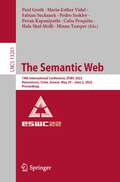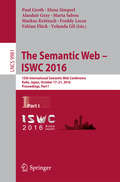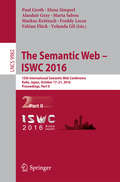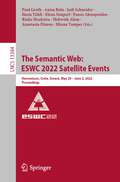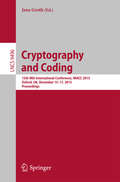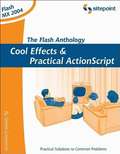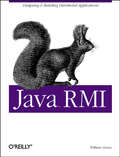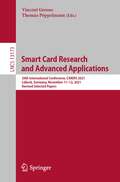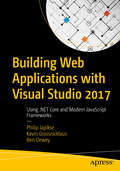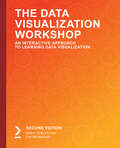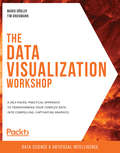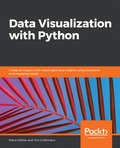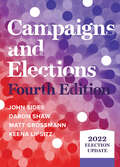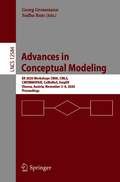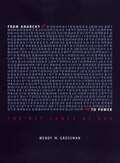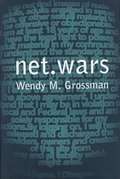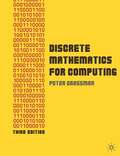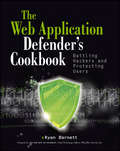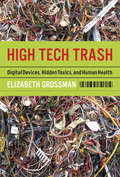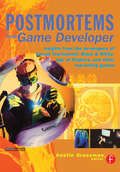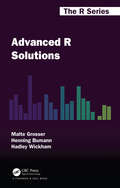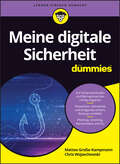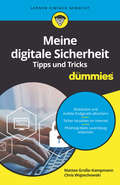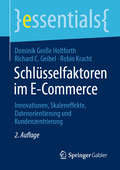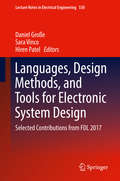- Table View
- List View
The Semantic Web: 19th International Conference, ESWC 2022, Hersonissos, Crete, Greece, May 29 – June 2, 2022, Proceedings (Lecture Notes in Computer Science #13261)
by Paul Groth Maria-Esther Vidal Fabian Suchanek Pedro Szekley Pavan Kapanipathi Catia Pesquita Hala Skaf-Molli Minna TamperThis book constitutes the refereed proceedings of the 19th International Semantic Web Conference, ESWC 2022, held in Hersonissos, Crete, Greece in May/June 2022. The 28 full papers presented were carefully reviewed and selected from 119 submissions. The papers are covering subjects related to semantic technologies, ranging from deep learning and knowledge graphs to integration for software development and ontologies. The quality of the accepted papers put the maturity level reached by the Semantic Web technologies into perspective. They provide evidence of the impact of these technologies in areas like data management, question answering, reasoning, programming languages, and machine learning.
The Semantic Web – ISWC 2016
by Paul Groth Elena Simperl Alasdair Gray Marta Sabou Markus Krötzsch Freddy Lecue Fabian Flöck Yolanda GilThe two-volume set LNCS 9981 and 9982 constitutes the refereed proceedings of the 15th International Semantic Web Conference, ISWC 2016, which was held in Kobe, Japan, in October 2016. The 75 full papers presented in these proceedings were carefully reviewed and selected from 326 submissions. The International Semantic Web Conference is the premier forum for Semantic Web research, where cutting edge scientific results and technological innovations are presented, where problems and solutions are discussed, and where the future of this vision is being developed. It brings together specialists in fields such as artificial intelligence, databases, social networks, distributed computing, Web engineering, information systems, human-computer interaction, natural language processing, and the social sciences. The Research Track solicited novel and significant research contributions addressing theoretical, analytical, empirical, and practical aspects of the Semantic Web. The Applications Track solicited submissions exploring the benefits and challenges of applying semantic technologies in concrete, practical applications, in contexts ranging from industry to government and science. The newly introduced Resources Track sought submissions providing a concise and clear description of a resource and its (expected) usage. Traditional resources include ontologies, vocabularies, datasets, benchmarks and replication studies, services and software. Besides more established types of resources, the track solicited submissions of new types of resources such as ontology design patterns, crowdsourcing task designs, workflows, methodologies, and protocols and measures.
The Semantic Web – ISWC 2016
by Paul Groth Elena Simperl Alasdair Gray Marta Sabou Markus Krötzsch Freddy Lecue Fabian Flöck Yolanda GilThe two-volume set LNCS 9981 and 9982 constitutes the refereed proceedings of the 15th International Semantic Web Conference, ISWC 2016, which was held in Kobe, Japan, in October 2016. The 75 full papers presented in these proceedings were carefully reviewed and selected from 326 submissions. The International Semantic Web Conference is the premier forum for Semantic Web research, where cutting edge scientific results and technological innovations are presented, where problems and solutions are discussed, and where the future of this vision is being developed. It brings together specialists in fields such as artificial intelligence, databases, social networks, distributed computing, Web engineering, information systems, human-computer interaction, natural language processing, and the social sciences. The Research Track solicited novel and significant research contributions addressing theoretical, analytical, empirical, and practical aspects of the Semantic Web. The Applications Track solicited submissions exploring the benefits and challenges of applying semantic technologies in concrete, practical applications, in contexts ranging from industry to government and science. The newly introduced Resources Track sought submissions providing a concise and clear description of a resource and its (expected) usage. Traditional resources include ontologies, vocabularies, datasets, benchmarks and replication studies, services and software. Besides more established types of resources, the track solicited submissions of new types of resources such as ontology design patterns, crowdsourcing task designs, workflows, methodologies, and protocols and measures.
The Semantic Web: Hersonissos, Crete, Greece, May 29 – June 2, 2022, Proceedings (Lecture Notes in Computer Science #13384)
by Paul Groth Anisa Rula Jodi Schneider Ilaria Tiddi Elena Simperl Panos Alexopoulos Rinke Hoekstra Mehwish Alam Anastasia Dimou Minna TamperThis book constitutes the proceedings of the satellite events held at the 19th Extended Semantic Web Conference, ESWC 2022, during May—June in Hersonissos, Greece, 2022. The included satellite events are: the poster and demo session; the PhD symposium; industry track; project networking; workshops and tutorials. During ESWC 2022, the following ten workshops took place:10th Linked Data in Architecture and Construction Workshop (LDAC 2022); 5th International Workshop on Geospatial Linked Data (GeoLD 2022); 5th Workshop on Semantic Web solutions for large-scale biomedical data analytics (SeMWeBMeDA 2022); 7th Natural Language Interfaces for the Web of Data (NLIWOD+QALD 2022); International Workshop on Knowledge Graph Generation from Text (Text2KG 2022); 3rd International Workshop on Deep Learning meets Ontologies and Natural Language Processing (DeepOntoNLP 2022); 1st Workshop on Modular Knowledge (ModularK 2022); Third International Workshop On Knowledge Graph Construction (KGCW 2022); Third International Workshop On Semantic Digital Twins (SeDIT 2022); and the 1st International Workshop on Semantic Industrial Information Modelling (SemIIM 2022).
Cryptography and Coding: 15th IMA International Conference, IMACC 2015, Oxford, UK, December 15-17, 2015. Proceedings (Lecture Notes in Computer Science #9496)
by Jens GrothThis book constitutes the proceedings of the 15th IMA International Conference on Cryptography and Coding, IMACC 2015, held at Oxford, UK, in December 2015. The 18 papers presented together with 1 invited talk were carefully reviewed and selected from 36 submissions. The scope of the conference was on following topics: authentication, symmetric cryptography, 2-party computation, codes, Boolean functions, information theory, and leakage resilience.
The Flash Anthology
by Steven GrosvenorA practical and fun Flash book that shows readers over 60 practical techniques, solutions and cool effects to instantly use on their Website or project. The Flash Anthology makes an excellent task reference or it can be used for inspiration for future projects. The book tackles the majority of the most common building blocks for real world Flash applications-as one reviewer described "it covers everything that Flash does best". Topics covered include working with external data, debugging, animation, sound and video effects, flash forms and getting indexed by search engines. All the solutions are based on ActionScript, are completely customizable and come with suggested modifications. Examples are compatible with ActionScript 2 and Flash MX 2004.
Java RMI
by William GrossoJava RMI contains a wealth of experience in designing and implementing Java's Remote Method Invocation. If you're a novice reader, you will quickly be brought up to speed on why RMI is such a powerful yet easy to use tool for distributed programming, while experts can gain valuable experience for constructing their own enterprise and distributed systems. With Java RMI, you'll learn tips and tricks for making your RMI code excel. The book also provides strategies for working with serialization, threading, the RMI registry, sockets and socket factories, activation, dynamic class downloading, HTTP tunneling, distributed garbage collection, JNDI, and CORBA. In short, a treasure trove of valuable RMI knowledge packed into one book.
Smart Card Research and Advanced Applications: 20th International Conference, CARDIS 2021, Lübeck, Germany, November 11–12, 2021, Revised Selected Papers (Lecture Notes in Computer Science #13173)
by Vincent Grosso Thomas PöppelmannThis book constitutes the proceedings of the 20th International Conference on Smart Card Research and Advanced Applications, CARDIS 2021, which took place in November 2021. The conference took place in Lübeck, Germany, and changed to a hybrid format due to the COVID-19 pandemic.The 16 full papers presented in this volume were carefully reviewed and selected from 32 submissions. They were organized in topical sections named Side-Channel Attacks, Fault Attacks, Public Key and Secure Implementations.
Building Web Applications with Visual Studio 2017: Using .NET Core and Modern JavaScript Frameworks
by Kevin Grossnicklaus Ben Dewey Philip JapikseLearn how to build web applications from three Microsoft MVPs. After building the data application layer using Entity Framework Core and a RESTful service using ASP. NET Core, you will then build the client side web application three ways: first, using ASP. NET Core, then using Angular 2, and, finally, using React. You will be able to compare and contrast these UI frameworks and select the best one for your needs. . NET Core is a complete rewrite of the popular . NET and its related frameworks. While many concepts are similar between . NET Core and the . NET 4. 6 framework, there are revolutionary changes as well, including updates to Entity Framework Core and ASP. NET Core. The first section of this book covers the three main parts of building applications with C#: Entity Framework, ASP. NET Core Services, and ASP. NET Core Web Applications. There is also an explosion in popularity of JavaScript frameworks for client side development, and the authors cover two of the most popular UI frameworks. Start with TypeScript for developing clean JavaScript, along with a client side build tool such as Gulp, Grunt, and WebPack. Using the same data access layer and RESTful service from the . NET Core application, you can rebuild the UI using Angular 2. Then, repeat the process using React, for a true comparison of building client side applications using ASP. NET Core, Angular 2, and React. What You'll Learn Understand the fundamentals of . NET Core and what that means to the traditional . NET developer Build a data access layer with Entity Framework Core, a RESTful service with ASP. NET Core MVC, and a website with ASP. NET Core MVC and Bootstrap Automate many build tasks with client side build utilities Who This Book Is For Intermediate to advanced . NET developers
The Data Visualization Workshop: An Interactive Approach to Learning Data Visualization, 2nd Edition
by Tim Großmann Mario DoblerCut through the noise and get real results with a step-by-step approach to learning data visualization with Python Key Features Ideal for Python beginners getting started with data visualization for the first time A step-by-step data visualization tutorial with exercises and activities that help build key skills Structured to let you progress at your own pace, on your own terms Use your physical print copy to redeem free access to the online interactive edition Book Description You already know you want to learn data visualization with Python, and a smarter way to learn is to learn by doing. The Data Visualization Workshop focuses on building up your practical skills so that you can develop clear, expressive real-world charts and diagrams. You'll learn from real examples that lead to real results. Throughout The Data Visualization Workshop, you'll take an engaging step-by-step approach to understand data visualization with Python. You won't have to sit through any unnecessary theory. If you're short on time you can jump into a single exercise each day or spend an entire weekend learning how companies like Uber are using advanced visualization techniques to represent their data visually. It's your choice. Learning on your terms, you'll build up and reinforce key skills in a way that feels rewarding. Every physical print copy of The Data Visualization Workshop unlocks access to the interactive edition. With videos detailing all exercises and activities, you'll always have a guided solution. You can also benchmark yourself against assessments, track progress, and receive content updates. You'll even earn a secure credential that you can share and verify online upon completion. It's a premium learning experience that's included with your printed copy. To redeem, follow the instructions located at the start of your book. Fast-paced and direct, The Data Visualization Workshop is the ideal companion for Python beginners who want to get up and running with data visualization. You'll visualize your work like a skilled data scientist, learning along the way. This process means that you'll find that your new skills stick, embedded as best practice. A solid foundation for the years ahead. What you will learn Get to grips with fundamental concepts and conventions of data visualization Learn how to use libraries like NumPy and Pandas to index, slice, and iterate data frames Implement different plotting techniques to produce compelling data visualizations Learn how you can skyrocket your Python data wrangling skills Draw statistical graphics using the Seaborn and Matplotlib libraries Create interactive visualizations and integrate them into any web page Who this book is for Our goal at Packt is to help you be successful, in whatever it is that you choose to do. The Data Visualization Workshop is an ideal tutorial for those who want to perform data visualization with Python and are just getting started. Pick up a Workshop today and let Packt help you develop skills that stick with you for life.
The Data Visualization Workshop: A self-paced, practical approach to transforming your complex data into compelling, captivating graphics
by Tim Großmann Mario DoblerExplore a modern approach to visualizing data with Python and transform large real-world datasets into expressive visual graphics using this beginner-friendly workshop Key Features Discover the essential tools and methods of data visualization Learn to use standard Python plotting libraries such as Matplotlib and Seaborn Gain insights into the visualization techniques of big companies Book Description Do you want to transform data into captivating images? Do you want to make it easy for your audience to process and understand the patterns, trends, and relationships hidden within your data? The Data Visualization Workshop will guide you through the world of data visualization and help you to unlock simple secrets for transforming data into meaningful visuals with the help of exciting exercises and activities. Starting with an introduction to data visualization, this book shows you how to first prepare raw data for visualization using NumPy and pandas operations. As you progress, you'll use plotting techniques, such as comparison and distribution, to identify relationships and similarities between datasets. You'll then work through practical exercises to simplify the process of creating visualizations using Python plotting libraries such as Matplotlib and Seaborn. If you've ever wondered how popular companies like Uber and Airbnb use geoplotlib for geographical visualizations, this book has got you covered, helping you analyze and understand the process effectively. Finally, you'll use the Bokeh library to create dynamic visualizations that can be integrated into any web page. By the end of this workshop, you'll have learned how to present engaging mission-critical insights by creating impactful visualizations with real-world data. What you will learn Understand the importance of data visualization in data science Implement NumPy and pandas operations on real-life datasets Create captivating data visualizations using plotting libraries Use advanced techniques to plot geospatial data on a map Integrate interactive visualizations to a webpage Visualize stock prices with Bokeh and analyze Airbnb data with Matplotlib Who this book is for The Data Visualization Workshop is for beginners who want to learn data visualization, as well as developers and data scientists who are looking to enrich their practical data science skills. Prior knowledge of data analytics, data science, and visualization is not mandatory. Knowledge of Python basics and high-school-level math will help you grasp the concepts covered in this data visualization book more quickly and effectively.
Data Visualization with Python: Create an impact with meaningful data insights using interactive and engaging visuals
by Tim GroßmannData Visualization with Python is designed for developers and scientists, who want to get into data science, or want to use data visualizations to enrich their personal and professional projects. You do not need any prior experience in data analytics and visualization, however it’ll help you to have some knowledge of Python and high school level mathematics. Even though this is a beginner level course on data visualization, experienced developers will benefit from improving their Python skills working with real world data.
Campaigns and Elections (Fourth Election Update Edition): 2022 Election Update
by Matt Grossmann John Sides Keena Lipsitz Daron ShawThe #1 book examines contemporary campaigns and elections—now updated through 2022. Thoroughly revised and updated through the 2022 elections, the Fourth Edition of Campaigns and Elections uses a consistent framework to reveal the strategies and choices that face candidates and other practitioners in the American political system. The authors help students answer the many questions they have about campaigns while spotlighting contemporary political science research in the process. This purchase offers access to the digital ebook only.
Advances in Conceptual Modeling: ER 2020 Workshops CMAI, CMLS, CMOMM4FAIR, CoMoNoS, EmpER, Vienna, Austria, November 3–6, 2020, Proceedings (Lecture Notes in Computer Science #12584)
by Georg Grossmann Sudha RamThis book constitutes the refereed proceedings of five workshops symposia, held at the 39th International Conference on Conceptual Modeling, ER 2020, which were supposed to be held in Vienna, Austria, in November 2020, but were held virtually due to the COVID-19 pandemic instead.The 20 papers promote and disseminate research on theories of concepts underlying conceptual modeling, methods and tools for developing and communicating conceptual models, techniques for transforming conceptual models into effective implementations, and the impact of conceptual modeling techniques on databases, business strategies and information systems. The following workshops are included in this volume: First Workshop on Conceptual Modeling Meets Artificial Intelligence and Data-Driven Decision Making (CMAI); First International Workshop on Conceptual Modeling for Life Sciences (CMLS); Second Workshop on Conceptual Modeling, Ontologies and (Meta)data Management for Findable, Accessible, Interoperable and Reusable (FAIR) Data (CMOMM4FAIR); First Workshop on Conceptual Modeling for NoSQL Data Stores (CoMoNoS); and Third International Workshop on Empirical Methods in Conceptual Modeling (EmpER).
From Anarchy to Power: The Net Comes of Age
by Wendy GrossmanCompanion website: http://www.nyupress.org/fap Yesterday's battles over internet turf were fought on the net itself: today's battles are fought in government committees, in Congress, on the stock exchange, and in the marketplace. What was once an experimental ground for electronic commerce is now the hottest part of our economic infrastructure. In From Anarchy to Power, Wendy Grossman explores the new dispensation on the net and tackles the questions that trouble every online user: How vulnerable are the internet and world wide web to malicious cyber hackers? What are the limits of privacy online? How real is internet addiction and to what extent is the news media responsible for this phenomenon? Are women and minorities at a disadvantage in cyberspace? How is the increasing power of big business changing internet culture? We learn about the political economy of the internet including issues of copyright law, corporate control and cryptography legislation. Throughout the book the emphasis is on the international dimensions of the net, focusing on privacy and censorship in the United States, Europe and Canada and the hitherto ignored contributions of other countries in the development of the net. Entertaining and informative From Anarchy to Power is required reading for anyone who wants to know where the new digital economy is heading.
net.wars
by Wendy GrossmanFull text online version at www.nyupress.org/netwars. Who will rule cyberspace? And why should people care? Recently stories have appeared in a variety of news media, from the sensational to the staid, that portray the Internet as full of pornography, pedophilia, recipes for making bombs, lewd and lawless behavior, and copyright violators. And, for politicians eager for votes, or to people who have never strolled the electronic byways, regulating the Net seems as logical and sensible as making your kids wear seat belts. Forget freedom of speech: children can read this stuff. From the point of view of those on the Net, mass-media's representation of pornography on the Internet grossly overestimates the amount that is actually available, and these stories are based on studies that are at best flawed and at worst fraudulent. To netizens, the panic over the electronic availability of bomb-making recipes and other potentially dangerous material is groundless: the same material is readily available in public libraries. Out on the Net, it seems outrageous that people who have never really experienced it are in a position to regulate it. How then, should the lines be drawn in the grey area between cyberspace and the physical world? In net.wars, Wendy Grossman, a journalist who has covered the Net since 1992 for major publications such as Wired, The Guardian, and The Telegraph, assesses the battles that will define the future of this new venue. From the Church of Scientology's raids on Net users to netizens attempts to overthrow both the Communications Decency Act and the restrictions on the export of strong encryption, net.wars explains the issues and the background behind the headlines. Among the issues covered are net scams, class divisions on the net, privacy issues, the Communications Decency Act, women online, pornography, hackers and the computer underground, net criminals and sociopaths, and more.
Discrete Mathematics for Computing (3rd Edition)
by Peter Grossman<p>Palgrave Macmillan Discrete Mathematics for Computing is suitable for students taking a one-semester introductory course in discrete mathematics, particularly those studying Computing and Informations Systems. It presents the essential mathematics needed for computing in a style suitable for students with only a moderate background in the subject. <p>Material is introduced at a gentle pace and in an informal style, without compromising mathematical integrity. The text includes many examples of how the theory is applied to problems in computing. This third edition includes: a new expanded section on encryption, additional examples to illustrate key concepts, new exercises at a variety of levels. <p>Peter Grossman has worked in universities and industry as a mathematician and computing professional. As a lecturer in mathematics, he was responsible for coordinating and developing mathematics courses for computing students. He has applied his skills in areas as diverse as calculator design, irrigation systems and underground mine layouts.
Web Application Defender's Cookbook
by Jeremiah Grossman Ryan C. BarnettDefending your web applications against hackers and attackersThe top-selling book Web Application Hacker's Handbook showed how attackers and hackers identify and attack vulnerable live web applications. This new Web Application Defender's Cookbook is the perfect counterpoint to that book: it shows you how to defend. Authored by a highly credentialed defensive security expert, this new book details defensive security methods and can be used as courseware for training network security personnel, web server administrators, and security consultants.Each "recipe" shows you a way to detect and defend against malicious behavior and provides working code examples for the ModSecurity web application firewall module. Topics include identifying vulnerabilities, setting hacker traps, defending different access points, enforcing application flows, and much more.Provides practical tactics for detecting web attacks and malicious behavior and defending against themWritten by a preeminent authority on web application firewall technology and web application defense tactics Offers a series of "recipes" that include working code examples for the open-source ModSecurity web application firewall moduleFind the tools, techniques, and expert information you need to detect and respond to web application attacks with Web Application Defender's Cookbook: Battling Hackers and Protecting Users.
High Tech Trash: Digital Devices, Hidden Toxics, and Human Health
by Elizabeth GrossmanThe Digital Age was expected to usher in an era of clean production, an alternative to smokestack industries and their pollutants. But as environmental journalist Elizabeth Grossman reveals in this penetrating analysis of high tech manufacture and disposal, digital may be sleek, but it's anything but clean. Deep within every electronic device lie toxic materials that make up the bits and bytes, a complex thicket of lead, mercury, cadmium, plastics, and a host of other often harmful ingredients.High Tech Trash is a wake-up call to the importance of the e-waste issue and the health hazards involved. Americans alone own more than two billion pieces of high tech electronics and discard five to seven million tons each year. As a result, electronic waste already makes up more than two-thirds of the heavy metals and 40 percent of the lead found in our landfills. But the problem goes far beyond American shores, most tragically to the cities in China and India where shiploads of discarded electronics arrive daily. There, they are "recycled"-picked apart by hand, exposing thousands of workers and community residents to toxics.As Grossman notes, "This is a story in which we all play a part, whether we know it or not. If you sit at a desk in an office, talk to friends on your cell phone, watch television, listen to music on headphones, are a child in Guangdong, or a native of the Arctic, you are part of this story."The answers lie in changing how we design, manufacture, and dispose of high tech electronics. Europe has led the way in regulating materials used in electronic devices and in e-waste recycling. But in the United States many have yet to recognize the persistent human health and environmental effects of the toxics in high tech devices. If Silent Spring brought national attention to the dangers of DDT and other pesticides, High Tech Trash could do the same for a new generation of technology's products.
Postmortems from Game Developer: Insights from the Developers of Unreal Tournament, Black & White, Age of Empire, and Other Top-Selling Games
by Austin GrossmanThe popular Postmortem column in Game Developer magazine features firsthand accounts of how some of the most important and successful games of recent years have been made. This book offers the opportunity to harvest this expertise with one volume. The editor has organized the articles by theme and added previously unpublished analysis to reveal successful management techniques. Readers learn how superstars of the game industry like Peter Molyneux and Warren Spector have dealt with the development challenges such as managing complexity, software and game design issues, schedule challenges, and changing staff needs.
Advanced R Solutions (Chapman & Hall/CRC The R Series)
by Malte Grosser Henning Bumann Hadley WickhamThis book offers solutions to all 284 exercises in Advanced R, Second Edition. All the solutions have been carefully documented and made to be as clear and accessible as possible. Working through the exercises and their solutions will give you a deeper understanding of a variety of programming challenges, many of which are relevant to everyday work. This will expand your set of tools on a technical and conceptual level. You will be able to transfer many of the specific programming schemes directly and will discover far more elegant solutions to everyday problems. Features: When R creates copies, and how it affects memory usage and code performance Everything you could ever want to know about functions The differences between calling and exiting handlers How to employ functional programming to solve modular tasks The motivation, mechanics, usage, and limitations of R's highly pragmatic S3 OO system The R6 OO system, which is more like OO programming in other languages The rules that R uses to parse and evaluate expressions How to use metaprogramming to generate HTML or LaTeX with elegant R code How to identify and resolve performance bottlenecks
Meine digitale Sicherheit für Dummies (Für Dummies)
by Matteo Grosse-Kampmann Chris WojzechowskiDigital einfach besser geschützt! Wie Sie Ihre Daten zuhause und im Internet vor Betrügern schützen, vermittelt Ihnen dieses Buch. Sichere Passwörter, Browser, Online-Banking, Schutz Ihres Heimnetzwerks und Ihrer Endgeräte, Backups wichtiger Daten oder deren Wiederherstellung: Leicht verständlich und systematisch lernen Sie, sich digital zu schützen. Sie erfahren, welche menschlichen Eigenschaften Angreifer ausnutzen, um beim Phishing oder anderen Angriffen erfolgreich zu sein. Mit konkreten Schutzmaßnahmen für alle gängigen Betrugsmaschen und technischen Schutzvorkehrungen sind Sie ab sofort gewappnet. Sie erfahren Alles über zentrale Grundlagen der digitalen Sicherheit Welche Betrugsmaschen es gibt und wie Sie sich schützen Wie Sie Ihre Daten, Ihr Netzwerk und Ihre Endgeräte absichern Wie Sie sich zum Beispiel bei Bankgeschäften online wirklich sicher bewegen
Meine digitale Sicherheit Tipps und Tricks für Dummies (Für Dummies)
by Matteo Grosse-Kampmann Chris WojzechowskiIdentitätsdiebstahl, Schadsoftware auf dem Rechner, Phishing-Mail? Wir wissen alle, welche Gefahren uns im digitalen Alltag drohen und doch verschließen wir oft die Augen davor. Dieses Buch zeigt Ihnen, warum eine skeptische Grundhaltung vonnöten ist und wie Sie pragmatisch und mit so wenig Zeitaufwand wie möglich wichtige Schutzmaßnahmen für sich und Ihre Familie ergreifen. Pflegen Sie Ihre Accounts, finden Sie sichere Online-Anbieter und erkennen Sie Spam- und Phishingmails auf einen Blick. Damit Sie nachts besser schlafen können.
Schlüsselfaktoren im E-Commerce: Innovationen, Skaleneffekte, Datenorientierung und Kundenzentrierung (essentials)
by Dominik Große Holtforth Richard C. Geibel Robin KrachtDas essential zeigt, wie digitale Innovationen, Customer Centricity, Skaleneffekte und Data Driven Marketing zu nachhaltigen Kundenbeziehungen und Wettbewerbsvorteilen im E-Commerce führen. Dazu werden die vier Schlüsselfaktoren im E-Commerce umfassend dargestellt. Leser und Leserinnen erhalten grundlegende Impulse für die Neuausrichtung von Geschäftsmodellen, zur Gestaltung von Wachstumsprozessen und zur Erzielung nachhaltiger Erträge. Das essential geht dabei über die übliche Auflistung von operativen To-dos hinaus und zeigt Faktoren auf, die digitalen Technologien und E-Commerce zu disruptiver Wirkung verhelfen.
Languages, Design Methods, and Tools for Electronic System Design: Selected Contributions from FDL 2017 (Lecture Notes in Electrical Engineering #530)
by Daniel Große Sara Vinco Hiren PatelThis book brings together a selection of the best papers from the twentiethedition of the Forum on specification and Design Languages Conference (FDL), which took place on September 18-20, 2017, in Verona, Italy. FDL is a well-established international forum devoted to dissemination of research results, practical experiences and new ideas in the application of specification, design and verification languages to the design, modeling and verification of integrated circuits, complex hardware/software embedded systems, and mixed-technology systems.Covers modeling and verification methodologies targeting digital and analog systems;Addresses firmware development and validation;Targets both functional and non-functional properties;Includes descriptions of methods for reliable system design.
